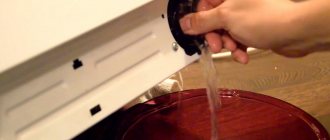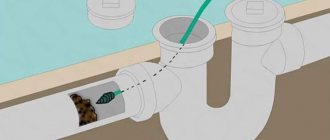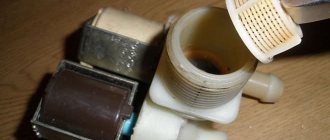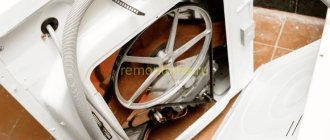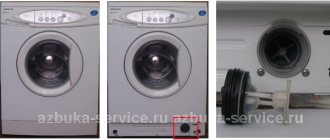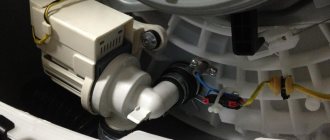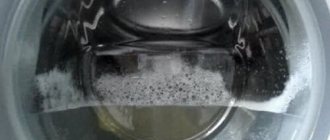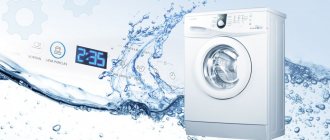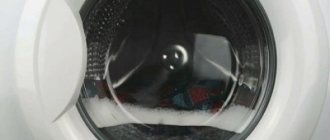The equipment of the Italian company Zanussi is reliable and easy to use, but even it can fail. No one is immune from breakdowns or manufacturing defects. Household appliances can also break down due to improper handling or makeshift repairs done without preparation. If, for example, a Zanussi washing machine does not drain water, then some users immediately begin to disassemble and clean it.
If you are not confident in your abilities, contact the service center. Or read our article. It will help you pinpoint the cause of the breakdown and develop a clear plan for repairing your washing machine yourself. Remember that first you always need to disconnect the equipment from the network, and only then begin diagnostics.
Diagnostics
Before starting repairs, you should check exactly how the drain or spin cycle is broken. This information will help you localize the location of the breakdown, which will allow you to repair your washing machine quickly and efficiently.
- Draining of liquid from the reservoir occurs extremely slowly.
- The next washing step does not start correctly.
- Water remains in the drum. The wash stops.
- After the end of the working cycle, a small amount of water remains at the bottom.
- No water is drained during the spin or rinse phase. It begins to decrease only at the end of the working cycle.
Malfunctions in the operation of the Zanussi washing machine can also occur due to the fault of the user. Make sure that the selected operating mode matches the type of laundry you are loading. Try changing the mode. This may be enough to start draining the water.
Never load the machine with more than the design allows. Not only will this disrupt operation, but it could also lead to more serious damage in the future.
The control module does not give a command to drain
The control board is the most technically complex component of the washing machine. It consists of many control elements, each of which is responsible for the operation of a specific actuator. Synchronization of the functioning of the elements occurs using a microprocessor - the most expensive part of the control module.
If the washing machine does not drain water, the triac responsible for this procedure may have failed. To check, first perform an autotest of the washing machine. The Zanussi washing machine user manual has detailed information on how to do this.
Usually it all comes down to the fact that after moving the programmer arrow to the required position and setting the zero temperature, all the buttons on the control panel are pressed simultaneously. After which an error code should be displayed, by which you can determine whether the control module is broken. You can more accurately determine the malfunction using a multimeter.
Preparation for repair
A faulty water drainage system prevents the wash from completing. A washing machine filled with water simply stops working. The first thing to do in this case is to try to reboot it. To do this, unplug the machine, wait a few minutes, and plug it into a power outlet. These steps can help fix a minor software glitch.
If this does not help, then before starting the repair, do the following:
- unplug the power cord;
- remove all water from the drum.
You can scoop out all the liquid from the washing machine using a regular ladle, but this method is not very effective. If the blockage occurs in the sewer, then you can drain the water through the drain hose, having first disconnected it from the sewer pipe.
There is also an emergency hose located at the bottom of the housing. It is hidden behind a removable panel. Users who have experience in repairing such equipment can independently disassemble the washing machine and drain the water by removing the drain pipe and filter.
The washing machine does not drain water, what should I do?
To begin, find out the reasons; troubleshooting may require the intervention of a professional. This is the most common breakdown, so specialists already have a recommended action plan:
Check the selected washing mode. Some models have a no-drain mode. You may have selected this particular option without even noticing.
- Check the condition of the drain hose. It could be bent or clogged. For prevention, it is recommended to clean it from time to time.
- If the drainage is carried out through a siphon, it makes sense to check its capacity.
- One of the most common problems is filter clogging. Anything can get into it: paper that has not been removed from pockets, labels, store receipts, tags, coins, pins, rhinestones, brooches, buttons and even bra underwires. Cleaning the filter is part of a set of periodic procedures that must be carried out during operation of the washing machine and should definitely not be neglected. Otherwise, it may cause even more serious problems.
- Lack of drainage may occur due to a clogged pipe if a handkerchief or sock has gotten into it.
- But if the washing machine does not drain water and hums or makes noise when draining, you may have a more serious problem. This symptom indicates a malfunction of the drain pump itself. When draining, the pump produces an uncharacteristic muffled hum, makes noise, but does not drain water. Only a professional can make a final diagnosis after carefully examining or disassembling the device. The drain pump may become unusable after 3-5 years due to natural wear and tear. Its performance may be affected by small parts that have leaked from the filter and blocked the impeller. Often, after disassembly, craftsmen remove wound hairs or threads from the pump.
- The cause of malfunction may be a violation of the integrity of the wiring inside the machine itself. As you understand, only a specialist can make such a diagnosis.
- Well, the last thing that can interfere with draining is a programmer or control board. If the microcircuit burns out, there is a failure in the firmware, or the programmer begins to act up, it will have to be replaced with a new one.
Blockage
An error in the operation of equipment can occur at any stage of operation. The most common reason why a Zanussi washing machine does not drain water or spin clothes is a blockage.
It can occur in such elements of the water drainage system as:
- drain hose;
- filter;
- pump impeller;
- drain pipe.
Breakdowns of this type can be easily repaired at home. The cleaning method depends on the nature of the problem. In some cases it is necessary to use specialized equipment.
The washing machine does not drain water - causes of malfunction
A washing machine is one household appliance without which it is difficult to imagine the life of a modern family. The assistant’s malfunctions unsettle her and only cause a large number of problems for the household. If the washing machine does not drain the water, then you should not try to do this instead; it is better to contact a professional service center. Using a faulty household appliance causes serious damage to the device and causes complex breakdowns.
Clogged drain system
If the washing machine does not spin or drain water, the first thing to check is the drainage system, which consists of a pipe between the tank and the pump, a drain filter, a drain pump, and a hose.
The simplest reason why the machine has stopped draining waste water is a pinched drain hose. This is easy to check; at the same time, you can feel the hose for blockages. The hose is connected to the sewer system and before major repair work it is worth checking to see if the sewer is clogged. To remove the blockage, you can call a plumber and try to solve the problem yourself.
Pipe clogged
We cleaned the drain hose, unscrewed the filter, but the water still did not come out. This means that the problem is in the pipe leading from the tank to the drain pump. It is necessary to disassemble the lower part of the washing machine, disconnect the pump, remove the pipe, and drain the water into a specially prepared container. The dirty pipe must be cleaned and rinsed under running water, and then returned to its original place and the washing machine must be completely reassembled. If you doubt that you can handle it on your own, then call our specialist, he will quickly solve the problem.
The drain hose is not connected correctly
If you were involved in self-installation and connection of the washing machine and after starting work the household appliance does not drain water and hums, then there is a high probability that you made serious mistakes while making the connection yourself. Stop using the washing machine and call a professional. If you want to solve the problem yourself, then the first thing we do is check that the drain hose is connected to the sewer system according to the instructions at a height of at least 60-70 cm from the floor. If the machine is installed correctly, the unpleasant smell from the sewer will not be able to penetrate into the room. Think carefully about all the advantages and disadvantages of connecting the machine yourself. Consider the possibility of leaks, problems with drainage, extraneous noise, and unpleasant odors if the washing machine is installed incorrectly. All this can be avoided by inviting a professional technician from our service center to connect the household appliance to the water supply and drainage system.
Pump malfunction
The pump or drain pump causes a lot of trouble for users of washing machines of the brands Indesit, Zanussi, Beko, Electrolux. The machine drains water for a long time when a part fails. Service specialists will promptly repair the most important component of your assistant. It is better not to carry out independent repairs, since the element is located differently in different models. To remove it, you need to thoroughly study the internal structure of the machine, and this requires time, which is usually not available, since the washing machine is the second necessary household item in the house after the kitchen stove. Preliminary diagnostics and visual inspection will help decide whether the element requires replacement, or whether routine preventative cleaning is sufficient.
Drain filter clogged
If the machine does not completely drain the water after the end of the washing program, the most common problem is a clogged filter, which can be cleaned without the help of a specialist. It is enough to open the lid at the bottom of the washing machine, unscrew the filter, drain the remaining water into a specially prepared container, rinse the part, and clean the filter seat. However, if you encounter difficulties removing the filter, we recommend calling a specialist. If you frequently start the machine at maximum temperature, there is a high risk of “welding” the filter to the body of the washing machine. We also note that in some models the filter is located outside the access area for ordinary users; in this case, we recommend contacting professional technicians.
Malfunctions of the electronic control module
The electronic control module, also called software, is responsible for transmitting signals and commands to other elements of the washing machine. If one of the components of the control unit breaks down, for example a stabilizer, the program stops and the machine does not drain water well. Self-repair is impossible, as it involves replacing the faulty part with an original spare part from a reliable manufacturer. Call us and have a technician come to your home; our warehouse always has the components necessary to restore faulty household appliances.
Impeller malfunction
The washing machine drain pump is the part most susceptible to wear, especially the pump impeller, which traps lint, coins, wire and other foreign objects. When cleaning the drain filter, do not forget to clean the impeller by first unscrewing the drain filter. Use a flashlight to better see the impeller and any debris in it. In some cases, you can find a whole lump of lint, thread and hair there. After cleaning is complete, try rotating the element; if turning is not difficult, it means the part has been cleaned well. If after completing the work the problem with draining the water remains, you need to call a specialist, he will diagnose the pump and other elements to accurately determine the cause of the malfunction.
Cleaning the drain filter and pipe
The filter is located at the bottom of the washing machine. It is hidden behind a removable panel made of the same material as the body. If you cannot find it and open it yourself, use the instructions. She will tell you what to do. Behind the panel there is an emergency hose and a pump filter. Please note that the filter is sealed with a rubber gasket.
In order to remove it, you need to apply some force. However, don't overdo it; some blockages may also prevent it from being removed. Once you have the filter in your hands, you can clean it by hand or with a brush.
The drain pipe is located in the machine body itself. It is highly not recommended to dismantle it yourself. Call specialists to your home. If you are confident in your abilities, then using the instructions, you can disassemble the washing machine and clean this part yourself.
The water drainage system is clogged
If the water in your Zanussi washing machine does not drain, the first thing to do is check the filter and drain hose. Clogs in these washer elements can impede the free flow of water, making draining difficult or impossible.
You need to start with the drain filter. The filter element is located on the front of the device body in its lower part under a plastic cover or panel. To get to the filter, the protection must be opened (removed), and then unscrewed the element itself. Before doing this, you should place a low dish under it, because after dismantling the filter unit, residual water will flow out.
After the drain filter is unscrewed and the water is drained, it is necessary to thoroughly clean it of debris. You should also clean the installation hole, where dirt can accumulate.
If the problem with the lack of water drainage has not been solved in this way, we proceed to inspect the pipe that connects the pump and the tank of the washing machine. In order to get to the hose, you need to unscrew the bolts securing the drain assembly.
Having done this, the pipe can be removed quite easily. Here, as in the case of the filter, you should prepare a container in advance into which the remaining water in the system is drained. To check possible places where the pipe is clogged, it needs to be compressed in several places for seals. If any are present, the hose is clogged and needs to be cleaned. After this, the entire structure is assembled to its original state.
Inspection of the pump (pump)
The failure of this part can only be determined by the residual principle. Except in cases where it was preceded by the following events:
- extraneous sounds during draining and spinning;
- repeated minor malfunctions in the operation of the Zanussi washing machine.
Although you can replace the drain pump yourself, this should only be done when the warranty period has long expired. Otherwise, contact the service center. Repairing this type of fault takes a short amount of time.
Where to buy an original Zanussi drain pump
If the washing machine does not drain water due to a faulty pump, you need to call a technician. Original Zanussi pumps are installed in a well-known Odessa service center. It is better not to buy a pump yourself, since an incorrectly selected unit will not work.
By contacting a professional workshop, you don’t have to worry about where to buy an original drain pump. Pumps for all popular washing machine models are always available in the warehouse of a specialized service center. All that is required from the user is to place an order and wait for the technician. There is no doubt about the quality of the repair - it is guaranteed.
Hardware failures
Failure of the electronic elements of a washing machine is always associated with large expenses. No one will repair these devices. Craftsmen prefer to simply replace broken components. A faulty control unit can be recognized by the absence of signals on the front panel or by system error codes.
This type of breakdown also includes malfunctions of the water level sensor in the drum. Its malfunction leads to disruption of the drain and spin cycles due to the fact that it is directly connected to the pump. This part cannot be repaired. It can only be replaced at official Zanussi service centers.
The main causes of drainage problems
It is not surprising that owners have questions about why the washing machine does not drain water and what to do in this case. Faced with a situation where a device from the “automatic” category cannot independently remove water and start the pump, many users see error information on the display.
This type of malfunction is very common. There may be several reasons for this. If the washing machine does not drain water, this may indicate:
- the need to replace the electronic module;
- failures in the program;
- filter failure;
- pump malfunction;
- problems with the drain hose.
Other common reasons include the need to clean the filters. It would be a good idea to check the integrity of the wires on the washing machine. In addition, if household appliances have stopped draining water, it is worth carrying out “smart” diagnostics. Why is this so important? The thing is that problems with drainage can provoke serious malfunctions. So, this failure is often accompanied by a door blocking on the unit.
Other faults
Failures of this type are less common. They are usually associated with the secondary systems of the washing machine. This type of breakdown includes:
- drum bearing failure;
- malfunctions in the cleaning agent supply system;
- scale on the heating element;
- door lock.
It is extremely easy to determine whether a bearing is faulty. Spin the drum by hand. It will move with great difficulty, making grinding sounds. Bearings can be easily replaced at home, if disassembling such a device is not difficult for you.
A jammed door can be opened in several ways:
- Manually. Just use a thin metal ruler or spatula.
- Programmatically . Turn on the “rinse” mode. At the end of the cycle the door should open.
- Reboot . Unplug your device, then plug it back in after a few minutes.
Common problems
One thing is certain: all problems in the operation of the machine are most often associated with the negligence of the owner. This may be an ignored instruction or incorrect installation. Housewives often overload or underload the drum, creating imbalances.
Even more cases of breakdowns are associated with improper operation and foreign objects entering the working paths of the device. There are also options when repairs are made due to wear and tear of system components.
Blockage
Clogging is a problem for all Zanussi cars without exception. This can be either a simple model or a fairly advanced device, for example, Aquacycle 800 or 900. All brand machines are very sensitive to the quality of tap water.
When installing the machine, it is recommended to install a separate fine filter at the inlet. It’s inexpensive and you won’t have to frequently remove the consequences of blockages.
If the machine is connected directly to the water supply, you need to clean the inlet filter mesh. Removing the blockage looks like this:
- the supply hose is unscrewed;
- unscrew the input filter from the machine body;
- the mesh is removed;
- cleaned and, if necessary, soaked in vinegar or a mild descaling agent;
- the filter is assembled, screwed into the housing, and a supply hose is connected to it.
You can often repair a machine with your own hands in this way. The filter device includes a procedure for removing and cleaning the mesh.
Extraneous noise during operation
Extraneous noise is the most common problem. This phenomenon may be caused by the following reasons:
- drum imbalance due to underloaded or overweight laundry;
- damage to the bearing block.
It is worth noting that malfunctions of a Zanussi horizontal-loading machine in the form of extraneous noise in any operating mode will most likely require the intervention of a qualified specialist. The cause is parts of mechanical components. This could also be a fairly harmless case when the shock absorber of the engine block is weakened or unbalanced. But the reason may lie in damaged bearings. In this case, the entire unit must be replaced.
Top-loading machines use a different type of drum mounting. In devices of this type, the unevenness of the load in the area of the bearing block is small, so extraneous noise, if it does not arise from loading laundry, but is present in all operating modes, necessarily indicates the complexity of the problem. Specialist intervention is required.
Bad spin
Poor spinning of laundry is always associated with the inability to achieve the required drum speed. The reasons for this phenomenon may be:
- insufficient supply voltage. Checked with a meter;
- poor belt tension causing slippage. The damage can be eliminated either by tightening or replacing.
But most often the machine begins to spin poorly when the laundry is loaded incorrectly. It may be overweight or underweight. In all cases, imbalance occurs and electronic control does not allow the engine to develop the required speed.
The problem can be solved either by dividing the laundry into two portions for separate washes, or by adding a clean towel and other things to the tank to gain sufficient weight.
Malfunctions related to water supply, heating, drainage
Partially the case when water is not supplied to the machine is described above. The problem can be resolved by cleaning the device's inlet filter. But the machine may not take in water due to a broken pressure switch. This happens rarely, but it does happen.
Zanussi devices have a rather complex unit of this class (in most models it is electronic), so you should contact a specialist to check and replace it. Water may not be drawn due to insufficient pressure. In this case, the pressure switch simply does not detect its presence at the input. Solving this problem also requires the intervention of a specialist.
Lack of heating may be due to a broken heating element. Most Zanussi car models have a display or display system. If the heating element breaks down, an error appears on the warning device.
This may be a character-numeric code or a combination of diodes. Based on the display readings, you should find the “faults and troubleshooting” section in the instructions for the Zanussi washing machine and determine the cause of the breakdown.
To repair the heating element, you will need skills in using measuring instruments and a soldering iron. An electrical tester will be required. By measuring the resistance of the heating element, its serviceability or winding breakage is determined. In the latter case, the wire leads to the heater contacts are unsoldered, the element is unscrewed from its socket and replaced with a new one.
The most unpleasant situation is when water is thrown out of the machine during washing. There are cases when water flows in and at the same time it is discharged into the sewer. Such problems are associated with incorrect installation of the device. The upper level of the drainage path must be raised no lower than the level specified in the instructions for the model.
Typically, Zanussi devices require the hose to be positioned at a height of at least 60-80 cm from the point of entry into the sewer. There is a special clip on the body of the machine for attaching it. Therefore, if the machine begins to drain water at the same time as filling or throws it away during washing, you should check the location of the outlet hose.
Hatch lock
Zanussi cars are equipped with a rather fragile blocker. Its locking system (locking teeth) is made of plastic. In addition, electrical control elements are located inside the unit. If the blocker refuses to lock the lock, you should:
- open the door;
- in the area of its handle, find on the body a block with two screws securing the safety plate with a square hole;
- carefully bend the rubber cuff in this area, after first removing the thin wire clamp that holds it in place;
- find the blocker with your hand and fix it;
- unscrew the screws;
- remove the cover and pull out the blocker;
- disconnect the terminal with wires.
The blocker needs to be changed in any case. The device may show obvious mechanical damage in the form of broken plastic teeth. The unit may not turn on due to a breakdown of internal electronic components, so the only solution is to purchase a new blocker model.
If the unit breaks down during washing and you cannot open the door, you should remove the lower decorative panel of the washing machine; a special cable is hidden behind it. To open the door, just pull it. Then you should follow the above scheme to remove the blocker. The new node is installed in the reverse order of steps.
Drum jammed
For users, the concept of “jammed” is quite broad. In the form of a list of options and methods for troubleshooting, it looks like this:
- entry of a foreign object. The drum refuses to spin or stops unexpectedly during the washing process. On top-loading machines, blocking may occur due to the loading doors not being closed. The problem is eliminated by removing the interference that has fallen between the parts of the structure;
- initial startup failure accompanied by a humming noise. This is a clear indication of problems with the bearing block. It is recommended to call a specialist;
- no rotation with the sound of the engine running. The problem may be either a break in the drive belt or it flying off the pulleys. If it is possible to disassemble the case and check the condition of the element and correct it, this must be done.
The most difficult locking problem is a broken bearing or drum spider. In these cases, expensive repairs will be required. It is also unpleasant for foreign objects to get into the machine. When the drum jams, the structure of the apparatus is inevitably damaged.
Prevention of breakdowns
You can extend the life of your Zanussi washing machine by following a few simple recommendations from experts. Wash clothes in small batches. Heavy weight leads to rapid wear of bearings.
Use products that prevent the formation of scale on the heating element. If the voltage in your electrical network fluctuates, use stabilizers. This will help protect electronics from damage. And most importantly, clean the filter several times a year. By following these recommendations, you can avoid situations where the washing machine stops draining water during the spin cycle.
Most common reasons
Where to start looking for the reason why the Zanussi washing machine refuses to drain water and spin clothes?
You need to start with the simplest and most obvious, which does not require disassembling the washing machine, and then, gradually, move on to more complex and rare causes.
Let's start with the garbage filter. We unscrew it and check for dirt and foreign objects. This should be done even if you clean the filter regularly, since socks and other small items often get caught there during washing. If you don’t find anything in the garbage filter, disconnect the Zanussi washing machine from the network, water supply and sewerage, take it out to a free place, where it will be convenient to disassemble it. Turn the washer around backwards and remove the back wall. Check how well the belt is tensioned.
Remember! A loose belt can cause problems with draining and spinning. This is a common problem with Zanussi washing machines, so the belt is checked immediately after the garbage filter.
If everything is in order with the belt, put the back wall of the machine in place and do the following.
Hub
It is an integral part of the water removal system. If it is destroyed, the mechanism stops working correctly and drainage does not occur. Replacement required. Note that in rare cases it is difficult to find from spare parts suppliers. Then it is necessary to change the entire volute with the pump assembly.
remontcma.ru
An integral attribute of any household today is washing equipment. There are a huge number of washing machines on the market, with a large selection of functions, different sizes and price categories. Any of the automatic washing machines removes the owner from the washing process; you just need to set the program, the machine itself will fill and drain water, heat it and carry out a full washing cycle, from soaking to spinning the clothes. Unfortunately, washing machines fail and very often this happens due to improper operation or third-party influence. Let's look at one of the breakdowns that may require washing machine repair - the Zanussi washing machine does not drain water.
Causes
The first thing you should pay attention to is the drain filter of the washing machine. It is usually located under the front cover of the case on the right. You should unscrew it and check if it is clogged. Prepare the container, as all the water remaining in the machine will be drained from the filter hole.
After checking and making sure that the filter is clean, you need to check the drain pump. Using an ohmmeter, you should measure the resistance of the pump, and also check the contacts and wiring leading to it. If the pump shows no signs of life, it will need to be replaced.
Water may also not drain due to a faulty water level sensor. There is no correct signal from the sensor - voltage will not be supplied to the drain pump by the control module.
In the case when the filter and pump, as well as the water level sensor (pressosta) did not show any signs due to which the Zanussi washing machine does not drain water, the fault lies with the control board of the washing machine. Work on its restoration or replacement should be carried out only by qualified specialists. We recommend that you seek help from professional washing machine repair technicians.
Repair
If you have basic skills, you can make repairs related to a non-functioning drain yourself. But not always, because restoring the control module is only possible with the help of professional electronics engineers. They have the necessary experience, as well as components and software. Also, if you do not want to get involved in independent repairs, specialists can help you. When choosing a service center for repairing washing machines in Odessa, pay attention to the “Master” service department. Under our roof we have assembled master craftsmen who will repair your washing machine on the day you call. All repair work performed is guaranteed.
Return to section: Repair of Zanussi washing machines
remont-stiralnyh-mashin.od.ua
Identifying the breakdown and fixing it
After all the excess water has been drained, you can begin to determine the reason why the washing machine broke down. It is recommended to start with a filter for draining water. To do this, it must be inspected for defects and contamination.
Next, a visual inspection of the pump impeller takes place through the hole located under the filter for draining water. Most often at this stage it is possible to determine the presence of blockages inside the pump. If no problems can be found here, then the filter can be put back.
The water drainage hose and siphon are checked. This procedure requires the following manipulations:
- The hose is disconnected from the siphon;
- Next, the hose is immersed in a bucket;
- After this, you need to start the spin or drain program.
If the water was drained in this way, this will mean that the siphon and drain tube are clogged. If water still remains inside the drum, then the search for damage must be carried out inside.
If the water fails to escape through the filter, then there is probably a serious blockage between the pipe and the pump. In this case, you should disassemble the machine, remove the pump and inspect all existing pipes for the presence of foreign objects.
If, when disassembling the pump, it was not possible to detect any faults in it, then the reason for the inability to drain all the water from the washing machine tank most likely lies in the control module. Using a multimeter, you need to check whether voltage is supplied to the control module. If there is no voltage supply to the module, it must be replaced with a working one. It is best to carry out all work on the internal electronics of a washing machine with the proper knowledge.
By carrying out all the troubleshooting procedures, you can be guaranteed to find the reason why the water in the tank does not drain. If you are unable to repair the washing machine yourself, then the best way out of the situation would be to contact a qualified technician or a specialized service center.
stiralkovich.ru
Drain hose
A clogged hose is a fairly common situation. And there are treacherous circumstances. For example, a coin gets stuck. This is difficult to determine.
To clean, perform the following steps:
- put the car on its side;
- cover the motor with a plastic bag;
- disconnect the drain hose from the pump, after first removing the metal clamp with pliers;
- get out of the car;
- rinse under running water;
- install back.
Advice. The hose is corrugated, so squeezing and unclenching will help clean it.
Foreign objects in the pump
Unscrew the cap and pull out the concentrator. Rinse it. Remove all objects from the “pump volute” and also free the impeller. Make sure it rotates freely.
Note that not only toothpicks and wool fibers fall into the pump, but also socks with spoons, as well as hairpins, pins, bolts, nuts, and seeds.
Advice! It is important to place small items in special laundry bags.
Quite often, this leads to premature wear of the pump and its breakdown.
